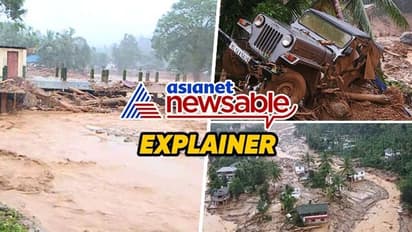Wayanad landslide explainer: Why Kerala faces disasters every monsoon

Synopsis
Heavy rains triggered a devastating landslide and flood in Kerala's Wayanad district, causing over 100 deaths and 250 missing. The death toll is suspected to cross 150. The disaster spanned 18 km, burying villages and flooding towns. Rescue operations continue amidst overwhelming hospital conditions and makeshift refugee centres. Changing climate and deforestation are major donors to these frequent natural disasters in Kerala.
In the quiet of the night, with the town sleeping, nothing could be heard except the roar of rainfall. The bright green tea and coffee estates looked dull under the dark sky. Suddenly, at 1 o'clock on Tuesday midnight, a hill collapsed, rushing toward the houses in the foothills along with water. It happened again at 2 o'clock, and once more at 4 am. This tragic sequence led to a devastating landslide and flood in Kerala's Wayanad district, due to heavy rains.
Death toll likely to cross 150
This disaster, spanning about 18 km, has shocked the nation. The death toll continues to rise, with more than 250 people missing and over 150 suspected dead. Rescue operations are ongoing, but many remain unaccounted for. Hospitals are overwhelmed, and mosques, madrasas, temples, and churches have been converted into temporary hospitals. Refugee centres have been set up to accommodate the displaced.
Kedarnath to Darjeeling, five worst landslides in India's history
10 houses remain out of 400
The entire village was buried under the hill, with only 10 houses remaining out of more than 400. This catastrophe struck Meppadi, Mundakkai, Chooralmala, and the surrounding areas. As locals rushed out of their homes to save their lives, they were engulfed by the mudslides. The tragedy unfolded near the Tree Valley Resort, where overnighters joined the locals in their efforts.
Dead bodies came floating like sheets in the river
The Chaliyar River, next to Meppadi, overflowed beyond the danger level. Heavy rains of about 30 cm caused the adjacent hillocks, Chembra and Vellari, to collapse onto Meppadi and Mundakkai. The river's direction changed, flooding the entire town. Tourist vehicles, cars, bikes, and even bundles of belongings were seen floating in the river in the Nilambur area of Malappuram. Many bodies were recovered from the river, with more suspected to have been washed away.
Wayanad, once a popular tourist destination, is now unrecognizable. The lush greenery has been replaced by mud and debris. Huge boulders and muddy water flow where rivers and towns once stood. The beauty of Wayanad has been marred by this disaster, making it hard to identify the once-picturesque region.
Massive landslide strikes Kerala's Wayanad: Over 250 people missing, several dead; See PICS
2018 Kerala floods
In 2018, Kerala faced its worst disaster in history with floods that killed 483 people. Between 1961 and 2016, around 295 people died due to landslides in Kerala. More than 100 lives were lost due to rain disasters during the monsoons of 2019 and 2020.
In 2021, multiple landslides and floods in Kerala's Kottayam and Idukki districts killed 53 people. According to the Ministry of Earth Sciences, Kerala experienced the highest number of landslides in the country from 2015 to 2022, with 3,782 incidents recorded.
What might be the reason behind landslides?
The changing rainfall patterns in Kerala over the past few years have contributed to the landslides. Additionally, the destruction of forests in the Western Ghats for resorts, hotels, and urbanization has worsened the situation. Climate change and human activities have played a significant role in these disasters.
Wayanad landslides: Death toll surpasses 100, massive rescue ops underway; several still missing
Kodagu 2018 disaster
Between August 10th and 17th, 2018, heavy rains in Karnataka's Kodagu led to several landslides, killing 20 people. The disaster damaged 4,056 houses and displaced 18,000 people. The construction of resorts by digging up hillocks was a major cause of this disaster.
Despite being known as "God's Own Country," Kerala faces frequent natural disasters, especially during the monsoon season. The combination of changing weather patterns, deforestation, and human activities has made the state vulnerable to landslides and floods.
Stay updated with the Breaking News Today and Latest News from across India and around the world. Get real-time updates, in-depth analysis, and comprehensive coverage of India News, World News, Indian Defence News, Kerala News, and Karnataka News. From politics to current affairs, follow every major story as it unfolds. Download the Asianet News Official App to stay informed anytime, anywhere.